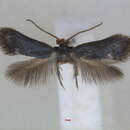Pectinivalva acmenae
(
İngilizce
)
wikipedia EN tarafından sağlandı
Pectinivalva acmenae is a moth of the family Nepticulidae. It is found in New South Wales.
The wingspan is 4.5–5.5 mm for males and 5.2–5.6 mm for females. The thorax, tegulae and forewings are uniform shining dark grey with strong blue reflections. There is an inconspicuous tornal spot consisting of a few white scales. The hindwings are pale grey.[1]
The larvae feed on Syzygium smithii. They mine the leaves of their host plant. The mine has the form of a long, very narrow contorted gallery, filled with brown frass apart from irregular crenulations along the mine edge. The exit-hole is located on the underside and has the form of a semicircular hole. Pupation takes place in a reddish-brown cocoon.
Etymology
The specific name is derived from the former host-plant genus. Because the moth is referred to under this manuscript name in the first author's unpublished thesis, the authors have chosen to retain it for consistency, in spite of the change in classification of the host-plant.
References

- lisans
- cc-by-sa-3.0
- telif hakkı
- Wikipedia authors and editors
Pectinivalva acmenae: Brief Summary
(
İngilizce
)
wikipedia EN tarafından sağlandı
Pectinivalva acmenae is a moth of the family Nepticulidae. It is found in New South Wales.
The wingspan is 4.5–5.5 mm for males and 5.2–5.6 mm for females. The thorax, tegulae and forewings are uniform shining dark grey with strong blue reflections. There is an inconspicuous tornal spot consisting of a few white scales. The hindwings are pale grey.

Mine
The larvae feed on Syzygium smithii. They mine the leaves of their host plant. The mine has the form of a long, very narrow contorted gallery, filled with brown frass apart from irregular crenulations along the mine edge. The exit-hole is located on the underside and has the form of a semicircular hole. Pupation takes place in a reddish-brown cocoon.
- lisans
- cc-by-sa-3.0
- telif hakkı
- Wikipedia authors and editors
Description
(
İngilizce
)
Zookeys tarafından sağlandı
Male (Fig. 12). Wingspan 4.5–5.5 mm. Head: frontal tuft ferruginous; collar inconspicuous, consisting of white, grey-tipped scales; eyecaps anteriorly white, posteriorly shining grey with bluish reflections; antennae shining dark grey, whitish beneath, ca. 35 segments. Thorax, tegulae and forewing uniform shining dark grey with strong blue reflections; an inconspicuous tornal spot consisting of a few white scales; cilia dark grey. Hindwing unmodified, pale grey; cilia pale grey. Underside: forewing grey with faint brassy reflections; hindwing grey. Abdomen shining dark grey; anal tuft inconspicuous, dark grey.
Female (Fig. 13). Wingspan 5.2–5.6 mm. Similar to male, but antenna with 23–25 segments, and forewing rather broader. Wing venation as in Fig. 36. Abdominal tip not as broad and ‘square’ as in females of other Pectinivalva spp.
Male genitalia(Figs 52–54, 66). Capsule ca. 425 μm long, forming a narrow triangle. Anterior edge of vinculum excavated in a half-oblong. Tegumen rounded, with ventral extensions on each side overlapping lateral arms of gnathos. Uncus rectangular, bilobed, lobes slightly produced, with 3 setae on each. Gnathos central element long, reaching just beyond uncus, ending in small swelling. Valva (Fig. 53) ca. 210 μm long, squarish, more rounded caudally and produced into a short point at exterior corner of apex; apical ½ with numerous spine-like setae on dorsal surface; pectinifer consisting of ca. 18 spine-like elements. Long sublateral processes present. Juxta a weak subcircular plate. Aedeagus (Figs 54, 66) ca. 510 μm long, a curved spine arising towards apex on left, a shorter spine to right of this one, a third spine in line with second and anterior to it. Vesica basally with cathrema surrounded by a field of many broad, short cornuti; a separate field of ca. 9 long narrow cornuti above opening of ejaculatory duct.
Female genitalia(Fig. 77, 92–94). Total length ca. 760 μm. T9 prominent, with a group of 5–6 setae on each side. Apophyses anteriores rather narrow, curved inwards; apophyses posteriores narrow, straight, approximately equal in length to anteriores. Lateral sclerotizations of vestibulum strongly developed, forked, the bifurcations diverging widely, anterior pair blunt, posterior pair pointed. Ductus spermathecae with 4½ convolutions. Posterior part of corpus broad, folded, without markings; anterior part rounded, with rows of inconspicuous pectinations; signum consisting of broken linear sclerotization surrounded by oval sclerotized ring with blunt dentitions.
Larva. Green. Length of head ca. 440 μm; width ca. 350 μm. Thorax: prothoracic sternite in shape of Y with expanded base (Fig. 113); an additional small roundish sclerite on each side of this and antero-dorsal to SV and V group of setae. Chaetotaxy and spinosity: T2 with 11 pairs of setae (L3 present); otherwise as described for subgenus Casanovula. Anal rods distinctly forked posteriorly.
- lisans
- cc-by-3.0
- telif hakkı
- Robert J.B. Hoare, Erik J. van Nieukerken
- bibliyografik atıf
- Hoare R, Nieukerken E (2013) Phylogeny and host-plant relationships of the Australian Myrtaceae leafmining moth genus Pectinivalva (Lepidoptera, Nepticulidae), with new subgenera and species ZooKeys 278: 1–64
- yazar
- Robert J.B. Hoare
- yazar
- Erik J. van Nieukerken
Distribution
(
İngilizce
)
Zookeys tarafından sağlandı
New South Wales. Vacated mines probably of this species were seen abundantly along the coast near Manley, Sydney.
- lisans
- cc-by-3.0
- telif hakkı
- Robert J.B. Hoare, Erik J. van Nieukerken
- bibliyografik atıf
- Hoare R, Nieukerken E (2013) Phylogeny and host-plant relationships of the Australian Myrtaceae leafmining moth genus Pectinivalva (Lepidoptera, Nepticulidae), with new subgenera and species ZooKeys 278: 1–64
- yazar
- Robert J.B. Hoare
- yazar
- Erik J. van Nieukerken


 Mine
Mine